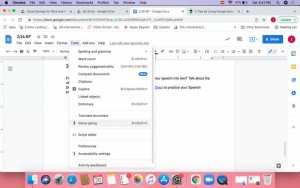Without a doubt, the complaint that I most often hear from my students is that they don’t get to speak and practice their Spanish enough. And this is totally understandable. Think about it. Unless you are learning Spanish in a Spanish speaking country the chances of being able to speak your target language, on a regular basis, are slim.
Now, if you are here my guess is that you feel the same way. If that’s the case, then let me get you in a little secret: the most important aspect of speaking a new language is not only having someone to speak it with, it is becoming comfortable with listening to yourself speak in this language. Believe me when I tell you, even if you had a conversation partner, it would be hard at first to feel comfortable enough to actually hold a conversation in Spanish. And this is true regardless of how many hours you spend working on exercises in your grammar book.
In this post, I’m going to present you with 3 easy, simple and free ways to speak in Spanish (all by yourself) that you can use at any time and anywhere. Any of these techniques, or better yet, all combined are sure to help you familiarize yourself with the sounds of Spanish and increase your vocabulary faster than you can say Vamos!
1. Say it out loud:
Another common complaint I hear from students is that they tend to understand more than they can speak. In other words, their listening skills are stronger than their speaking skills. I’m confident that all that is needed is to give yourself some speaking time to grow your confidence. This is why the best thing you can do is to just speak out loud. Now, I’m not just saying that you should talk to yourself in the mirror. That’s just not realistic or sustainable (though it could be fun to try it once in a while). Instead, I would recommend that you try something a bit more proactive:
a) Read aloud from a book, article or even Instagram post!
In practice, reading aloud is pretty much the same thing as speaking. And what’s helpful about this is that you don’t have to worry about what you’re actually saying. And the more you read the more comfortable you will become with sentence structure in Spanish.
If you want my advice, choose books, articles or Internet posts that resemble everyday speech. Something like Don Quijote de la Mancha or Cien Años de Soledad are great but no one talks like that in modern times. Instead, find a young adult novel or short stories in Spanish. Read the online script of a show or the transcript of an interview. Make this a daily or weekly habit and you will see fast improvement. Guaranteed!
b) Record yourself:
This tip can be used in conjunction with the previous point. If you want to take your speaking practice up a notch then record yourself reading your daily text. Then listen to the audio (as you read to yourself) and pay attention to your pronunciation and intonation (no judging allowed!) Be patient with yourself and embrace your own voice in Spanish. It will get better and become easier with time and practice. Pro Tip: Find a popular speech in Spanish and make that your reading text. Look up the audio on YouTube or online and listen to the original source to help you work on your pronunciation. And oh! You will be unstoppable!
c) Create an Instagram account or social media account dedicated to learning Spanish:
This might require you to step outside of your comfort zone (as many things that are worth in life do), but did you know that Instagram is full of language enthusiasts helping each other practice their target languages. Be brave and post videos of yourself reading or speaking Spanish and receive feedback from others. Now, I know the internet can sometimes be a scary place but in this case, the reward might be worth the risk!
2. Befriending Siri and Alexa:
You might be familiar with Siri and Alexa. But just in case you are not, Alexa is “Amazon’s virtual assistant technology based on a Polish speech synthesizer”. If you own an Alexa, you are probably used to giving Alexa commands such as: “Alexa, what’s time is it?”. But can Alexa do more than that? Well, as it turns out, Alexa can be set up to help you practice your Spanish.
I mean, it doesn’t get closer to having a conversation partner than that!
You can choose between keeping Alexa in English and simply asking her to help you practice Spanish, or take it to the next level and set it up to be fully in Spanish. To do this simply log into your Amazon online account, in the drop down menu choose “Alexa Skills”. Click on “Languages” and select Spanish. To finish up, choose “Get This Skill” and you will get access to all the content that’s offered.
Likewise, Siri (Apple’s virtual assistance) can also be a helpful conversation tool. Even though Siri cannot be set up to speak both English and Spanish, you can set it up to be completely in Spanish (if you’re up to the challenge!) To do this on your iPhone, “go to Settings > Siri & Search. Tap Language to change the language that Siri uses for requests and responses. Tap Siri Voice to change the voice that Siri speaks. To hear spoken responses from Siri on your device, tap Settings > Siri & Search > Siri Responses”.
In preparation for this post, I tried this myself and I have to tell you, it is FUN! Here are some extra steps I would highly recommend: Make sure you activate the Listen for “Oye Siri” option. This will take you to teaching Siri to recognize your voice in Spanish. On the screen, a series of phrases will appear that you will need to read in order for Siri to understand you in Spanish moving forward.
Similarly, I would strongly recommend that you go to Siri Responses and activate the options “Always Show Siri Captions” and “Always Show Speech” (see images below). These two settings will transcribe both what you say and what Siri responds to you! This will allow you to check your pronunciation as well as read and listen to what Siri says. How cool is that?
Then, you’ll be all set! Start by asking Siri and Alexa simple questions or by giving them easy commands in Spanish such as “Alexa, ¿qué hora es?” or “Siri, ¿cómo está el clima hoy?” and even “Alexa, ¿cómo se dice [insert word you wish to translate] in Spanish?”. The possibilities are endless with speech recognition technology. Embrace it and take advantage of it! Also, next time you have your friends over, you can impress them by asking Alexa in Spanish to, perhaps, play your favorite Spanish song? ¡Vaya!
3. Dictation, dictation, dictation:
Finally, how about not only reading in Spanish but turning your speech into text? Talk about the ultimate speaking test! Am I right?
Did you know that you can use a tool as simple as Google Docs to practice your Spanish pronunciation and fluency?
To activate this setting, all you need to do is:
- Log into your Gmail Account.
- Go to Apps and open Google Docs.
- Open a new document and go to Tools. In the display menu, click on “Voice Typing”. (see image below)
- You will see a microphone icon pop up. Click on Language and change it to Spanish.
- Start talking, mis amigos!
You can use this in different ways. Just get creative!
Here are some ideas: You can read from a book; you can say your own words; or you can repeat after a movie or podcast. The ability to see your speech come to life in written form will help you not only check your pronunciation (as in, are the words being spelled correctly?) but also it will increase your confidence in your own Spanish fluency. The more you see that text be exactly what you are speaking, the better you will feel!
Google Docs also offer the advantage of keeping all your text in one place.
Pro Tip: Start your own journal in Spanish by speaking a few sentences about your day every night before bed. And if you are taking a Spanish class, you can repeat what you learn into your Google Doc.
Lastly, if you feel that using your phone is more convenient for you, just download the app and follow the same instructions.
And there you have it! 3 easy, free, and technologically advanced ways to practice your speaking skills in Spanish. Start with one or try them all and see what you like the best. The key here is to keep a consistent practice that will help you increase your confidence as you improve your pronunciation. If you are a beginner, I highly recommend that you begin incorporating speaking practice on your own. Then, track your progress if you ever get a Spanish tutor or join an online group class. These techniques can serve as an excellent warm-up routine so that when you get to class you are ready to speak!
Do you know any other ways to practice your Spanish speaking skills on your own? Let me know in the comments!
Isabel Solano



